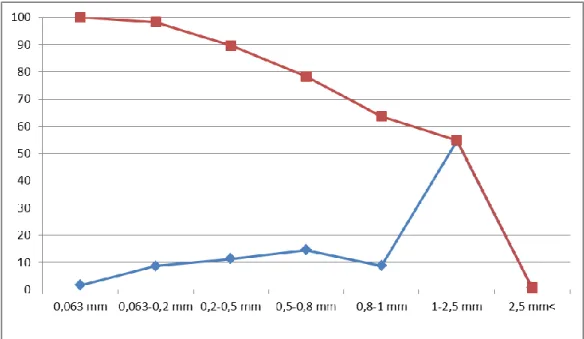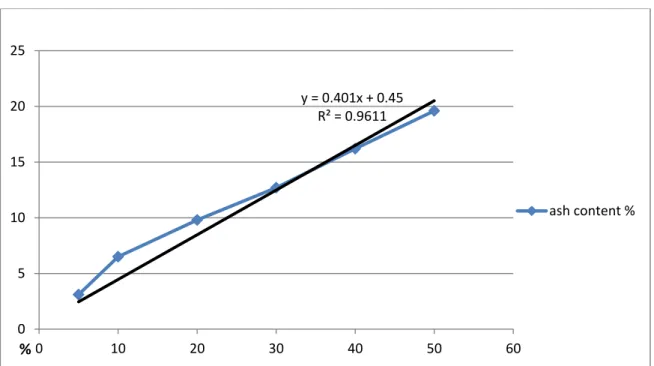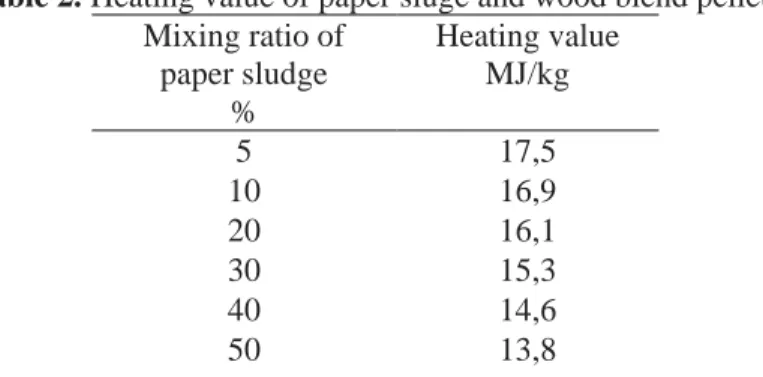IOP Conference Series: Earth and Environmental Science
PAPER • OPEN ACCESS
Production and laboratory testing of paper sludge and wood chips blend pellets
To cite this article: V Papp et al 2019 IOP Conf. Ser.: Earth Environ. Sci. 307 012010
View the article online for updates and enhancements.
This content was downloaded from IP address 160.114.76.143 on 06/01/2020 at 14:14
2019 5th International Conference on Environment and Renewable Energy IOP Conf. Series: Earth and Environmental Science 307 (2019) 012010
IOP Publishing doi:10.1088/1755-1315/307/1/012010
Production and laboratory testing of paper sludge and wood chips blend pellets
V Papp,1 D Szalay,2 C Hodúr3 and I Czupy4
1PhD, MSc Environmental research, University of Sopron, Sopron, HU 2PhD, MSc Environment engineer, University of Sopron, Sopron, HU 3Professor, Head of Institute University of Szeged, HU
4Associate Professor, Head of Institute of Forest and Environm. Techniq. University of Sopron, HU
E-mail: papp.viktoria@uni-sopron.hu
Abstract. Pellets are not only made of wood or herbaceous plants. The use of various waste materials and their mixtures can also be used for energetic purposes. Waste pellets can be used in larger industrial plants or in combustion plants with appropriate flue gas cleaning and filtering equipment. During the research, pellets were produced of varying proportions of paper sludge and pine wood shavings as wood industrial by-products. The energetic properties of pellets and raw materials were investigated and extended our previous researches to produce an estimated energy balance for the use of paper sludge as pellet. The energy utilization of paper sludge is important because it is produced in large quantities in pulp and paper plants.
1. Introduction
The deposition or use of large amount of paper sludge which apperears during papermaking process creates a big challenge for producers. The effect of the tightening of EU environmental rules is also applied in Hungary. It is getting harder and more costly to deposit waste. This problem also affects the paper industry more sensitively because, due to the technology of cellulose and paper production, waste and byproduts are generated that can not be directly used in a particular factory. These materials are either excreted as wastes within the technological process, or they are separated as a sludge in sewage treatment equipments. In the worst case - they leave the system together with running water.
Of course, it is important to ensure that the effluent that leaves the factory contaminates the recipient waters as little as possible. Therefore, it is necessary to close the factory's circular water system as perfectly as possible, but it is also important to manage and clean the wastewater, which can be used to filter out floating and dissolved pollutants in the waste water. This, however, is another problem, namely, it requires a solution to the disposal of paper sludge [1].
The Hungarian literature dealing with paper sludge utilization is first published in 1994 by Isopy- Hernádi. They explore the possibility of energy use, but the study of paper sludge compression does not find domestic sources of literature. There is only few research in the field of paper sludge combustion technolgy, a study on a pelleting experiment is related to the topic, Kilborn-Wiever's 1984 research[2]. During their work, the properties of bark wood and paper sludge pellets were investigated and the economic questions of recovery were explored. In his dissertation Pozsmik dealing with environmental management issues of paper companies, covering the topic from an economic point of view [3]. The use of paper sludge in construction industry opportunities Szűcs-Badacsonyi published a study [4]. A study deals with the various possibilities of utilization and the centrifugation and drying
2019 5th International Conference on Environment and Renewable Energy IOP Conf. Series: Earth and Environmental Science 307 (2019) 012010
IOP Publishing doi:10.1088/1755-1315/307/1/012010
2
of sludge. [5]. The conversion of paper sludge to ethanol and energy utilization has already been investigated in 2003 [6].
The utilization of "black liqour" as name in literature spread is known in the EU as 12.8 million tonnes in Sweden and 11.5 million tonnes an year in Finland, with more than half the EU utilization in the two countries. Most of the paper sludge is used for its own energy supply, while recovering the energy during the gasification process. Of course, in these countries, the volume of wood-based paper production is the largest, while the major raw materials from other big producers, Germany and France, already have a higher level of recycled paper raw material [7]. Most of the related literature deals with the investigation of paper sludge gasification processes [8,9,10,11].
2. General and material characterization of paper sludge
From the point of formation place, two main parts can be distinguished: one is within the technological process, the other is the sludge resulting from the sewage treatment. Sludges produced in the technological process include materials from pulper and waste treatment equipment (graded materials for sand dredges and cleaners). The sludge produced during the treatment of sewage is a characteristic component of the scraping agent and filler material[12].
The EWC code number of the waste:
03 Fabric and cellulose suspension from paper production, wood processes and cardboard paper production
03 03 cellulose fiber suspensions, paper and cardboard manufacturing and processing wastes 03 03 10 fibrous residues, sludge filler material and sludge from mechanical separation
The annual volume in Hungary is 50,000 tons, according to Dunapack Zrt. and BME surveys, of which 42,000 tons are deposited. Its composition is variable, with an average of 6-40% of inorganic material, of which 6-27% SiO2, 13-17% Al2O3. Its main component is cellulose, 30-34%, hemicellulose 12-15%, lignin 11-15%. It may also contain other metallic materials, Fe2O3 0,2-0,5%;
CaO 0,8-2,6%; MgO 0,1-5,3%[1].
Because of the high inorganic content, energy recovery is difficult because often large amounts of ash and slag are produced. Ash content have been studied, so it is particularly important when examining the use of paper sludge in combustion.
PH is slightly alkaline, behaving like plant wastes in the environment, it will corrode and humify itself.
Stored in the environment, such as in soil, it changes soil microbial composition, causing the relative enrichment of cellulose decomposers (fungi and bacteria). The high degree of enrichment of these microorganisms also increases the biological control of the other nutrient content of the soil, such as nitrogen, so that N is incorporated into these microorganisms, and the plants grown on the soil can temporarily suffer from a N deficiency.
The temporary plant nutrient deficiency, on the other hand, results in an improvement in the nutrient supply and humus content of the soil following the breakdown of the paper sludge (and the destruction of degrading microorganisms). The substance is not dangerous, although its mild alkalinity and high cellulose content temporarily alter the microbiological and nutritional balance of the soil. Therefore, it should follow by monitoring or estimating and testing in advance.[12]
Due to the high carbon-to-nitrogen ratio, direct application to the soil, like the effects of uncompanded organic waste or untreated fertilizer, results the pentosane effect and high degree of enrichment of cellulose decomposing and sugar-producing species.
The most common and most commonly used utilization methods found in the literature are soil filling, reuse in paper production, incineration, agricultural utilization (fiber sludge improves soil structure, water retention, water permeability and reduces irrigation requirements). New possibilities for paper sludge utilization: construction use (cement and brick production), heat-insulating materials and additives, methane gas production, etanol, egg tray. [1,2, 13,14].
N-containing materials (sewage sludge, pig and poultry slurry) can be composted as mixed additive.
[15].
3. Materials and Methods
2019 5th International Conference on Environment and Renewable Energy IOP Conf. Series: Earth and Environmental Science 307 (2019) 012010
IOP Publishing doi:10.1088/1755-1315/307/1/012010
The approx. 60 kg of paper sludge prior to the tests was 30% moisture content. Therefore, the material was spread as natural drying, and pelleting started two days later, moisture content was measured to reach the optimum 11-12%. The material was compacted into small pieces of 0.5 to 2 cm thick and it was easy to crumble. The size of the fraction required for pelleting was produced with a hammer grinder. The average of the measurement results of the fractional analysis is illustrated by the following diagram.
Figure 1. Fraction analysis of paper sludge
After grinding 50 to 55% of the material was in the range 2.5 to 1 mm. Then the paper sludge was mixed in different proportions to the pine-based wood shavings. The pelletization was carried out with a Kahl type pellet press with flat sticker and feeding system.
Figure 2. Pellet press and feeding system
2019 5th International Conference on Environment and Renewable Energy IOP Conf. Series: Earth and Environmental Science 307 (2019) 012010
IOP Publishing doi:10.1088/1755-1315/307/1/012010
4
We investigated the changes in ash content and calorific value of pure paper sludge and mixtures of different proportions. The heating value was determined by calorimetric tests. The ash content was mesured by glow furnace system. The moisture content was continuously measured by automatic wet content analyzer.
4. Results
Paper sludge, as it contains large amounts of inorganic SiO2 and AlO3, has high ash content. The ash content was determined by a glow furnace test, the average of five samples was 39.8%. The calorific value was 11.8 MJ/kg for dry matter and 10.7 MJ / kg at 11% moisture before pelletization. By increasing the mixing ratio, a linear rise in ash content was expected, as demonstrated by the following equation, as shown in the first table.
Table 1. Ash content change in paper sludge and wood blend pellets paper sludge mixing
ratio %
5 10 20 30 40 50
ash content % 3,1 6,5 9,8 12,7 16,2 19,6
X denotes the mixing ratio, y the ash content of the samples. The a and b values of a * x + b = y¯
equation are the parameters of the regression equation. From a practical point of view, the intersection points are also important, as can be conclude the ash content of the base material. In the third figure, the ash content results and the regression line are visible.
Figure 3. Ash content change and regression line in blend pellets
The calorific value is decreased, as expected with the increase in paper sludge. Measurements were repeated three times, the mean of the results is shown in table 2.
In the course of our previous researches we are dealing with wood pellets and agripellets energy balance and EROEI (Energy Returned on Energy Invested), by the amount of invested and recoverable energy[16]. When using paper sludge as a pellet, EROEI values are considerably smaller due to the relatively low calorific value than wood pellets or agripellets. The other problem is high humidity, to achieve optimum levels of 11-12% under operating conditions, significant energy input need for drying. Although there is no industrial data on pelletizing energy for paper sludge, an approximate
y = 0.401x + 0.45 R² = 0.9611
0 5 10 15 20 25
0 10 20 30 40 50 60
%
ash content %
2019 5th International Conference on Environment and Renewable Energy IOP Conf. Series: Earth and Environmental Science 307 (2019) 012010
IOP Publishing doi:10.1088/1755-1315/307/1/012010 value can be provided. An average value was taken into account from the technological energy demands presented in the previous research of wood pellet production (120 MJ / t for delivery, 1700 MJ / t for primary electric energy of pelletizing pellet, 1500 MJ / t for drying, 200 MJ / t for pellet delivery, etc.) so you can enter an estimated value for energy input. Assuming 80% efficiency in recovery, the calorific value of the samples tested can be estimated by the amount of recoverable energy[14]. By increasing the mixing ratio of the paper sludge due to the decreasing heat values, the EROEI values, of course, are also lower. Since the amount of recoverable energy is much lower than pure wood pellet, the EROEI estimates are also lower, at 50% mixing only around 2-3.
Table 2. Heating value of paper sluge and wood blend pellets Mixing ratio of
paper sludge
%
Heating value MJ/kg
5 17,5
10 16,9
20 16,1
30 15,3
40 14,6
50 13,8
5. Conclusions
The use of paper sludge as pellet raises a number of questions. Because of the high ash content, there is a problem with the equipment used for residential use, so only industrial scale utilization can be optimal. However, even in this case, there may be a problem due to high content of SiO2 and AlO3 due to possible slag formation and deposition. Attempts were made to firing paper sludge in power plants, co-firing technique could be a solution to the problem. The high moisture content of the sludge is also problematic during the pelletisation, because in order to achieve optimum moisture content of 11 to 12%
for pelletization, it would be necessary to obtain significant energy input for drying under operating conditions. And the calorific value is much lower than in wood pellets, so the estimated EROEI values are low. In the case of energy, it would be optimal to produce pellets if some kind of waste heat was used in the drying process of paper sludge.
6. References
[1] Hernádi S. 2009 – A papíriszap hasznosításának lehetőségei – Utilization of paper sludge, Papíripar, 53.vol/ 2. 42.pp.
[2] Kilborn J. F. – Wiever J. (1984) – Paper sludge pellet - http://infohouse.p2ric.org/ref/27/26418.pdf
[3] Pozsmik E. (2000) - A VÁLLALATOK KÖRNYEZETI MAGATARTÁSÁNAK VÁLTOZÁSA A PAPÍRIPAR PÉLDÁJÁN, CHANGES IN ENVIRONMENTAL BEHAVIOR OF COMPANIES IN THE EXAMPLE OF THE PAPER INDUSTRY –PhD dissertation, 32 pp.
[4] Szűcs, Antalné - Badacsonyi, Beatrix 1994 : Papíriszap környezetkímélő hasznosítása az építőiparban - Paper sludge utilization in buildings, Papíripar, 1994/ vol 6. pp. 214-215.
[5] Haan T. W. (2010) – Life circle assisment of pellet burning - http://www.forgreenheat.org/issues/docs/TomdeHaan.pdf
[6] Fan Z. –South C. –Lieford Z. (2003) - Conversion of paper sludge to ethanol in a semicontinuous solids-fed reactor –Bioprocess and Biosystem engineering 2003, Volume 26, pp 93–101
[7] European Comission Bioenergy Report (2015) - Study on impacts on resource efficiency of future EU demand for bioenergy, 23. pp
[8] De Blasio C. (2016) - A study on supercritical water gasification of black liquor conducted in stainless steel and nickel-chromium-molybdenum reactors - Journal of Chemical Technology and Biotechnology, 2664 p.
2019 5th International Conference on Environment and Renewable Energy IOP Conf. Series: Earth and Environmental Science 307 (2019) 012010
IOP Publishing doi:10.1088/1755-1315/307/1/012010
6
[9] Lagenberg Nilson Emil (2012) - Study of Black Liquor Evaporator Fouling at Södra Cell Värö – PHD Thesis, - Department of Energy and Environment Division of Heat and Power Technology CHALMERS UNIVERSITY OF TECHNOLOGY Göteborg, Sweden 2012
[10] Empie, H. Jeff (2009) - Fundamentals of the craft recovery process. USA: Tappi Press.
p. 7. ISBN 1-59510-186-1.
[11] Europen Comission CORDIS (2004) - Technical and Commercial Feasibility Study of Black Liquor Gasification with Methanol/DME Production as Motor Fuels for Automotive Uses – BLGMF, 53. pp.
[12] BME wase assesment sheet 2011 – Budapesti Műszaki Egyetem Hulladék felmérés
[13] Pozsmik E. (2000) - A VÁLLALATOK KÖRNYEZETI MAGATARTÁSÁNAK VÁLTOZÁSA A PAPÍRIPAR PÉLDÁJÁN, CHANGES IN ENVIRONMENTAL BEHAVIOR OF COMPANIES IN THE EXAMPLE OF THE PAPER INDUSTRY –PhD dissertation, 62.pp.
[14] Papp V (2018) – Energetikai pelletek előállításásnak és hasznosítsának ökoenergetikai vonatkozásai - Eco energy aspects of production and utilization of energy pellets, PhD dissertation, 82 pp.
[15] Elvira, C., Sampedro, L., Dominguez, J., Mato, S., (1997) - Vermicomposting of wastewater sludge from paper-pulp industry with nitrogen rich materials. Soil Biology & Biochemistry 29 (3-4), 759–762.);
[16] Papp V.- Marosvölgyi B. (2013): A pellet mint megújuló energiaforrás előállítása, hasznosítása és energetikai értékelése- Energiagazdálkodás, 21 pp. ISSN 0021-0757.
Acknowledgement
The described work was carried out as part of the „Sustainable Raw Material Management Thematic Network – RING 2017”, EFOP-3.6.2-16-2017-00010 project in the framework of the Széchenyi 2020 Program. The realization of this project is supported by the European Union, co-financed by the European Social Fund.


